Abstract
Māori tribal and social histories are founded on whakapapa (genealogy). Whakapapa and the knowledge of one’s ancestry is what connects all Māori to one another and is the central marker of traditional mātauranga Māori (Māori knowledge). Knowledge of one’s whakapapa and ancestral links is at the root of Māori identity and heritage, which can be re-connected with even if a person has been dislocated from it by colonization, urbanization and/or marriage. The collective experiences of Māori are contextualized within whakapapa and narratives of iwi (tribe), hapū (sub-tribe) and whanau (family). Within the context of colonization, whakapapa as a meaningful epistemological framework has not been erased and continues to connect Māori to one another and our tribal lands, histories and stories. Whakapapa and Māori identity are underpinned by an epistemology based on Māori tikanga (customary practices) that take into account the importance of a collective vision. However, research on counseling with people of indigenous descent from Aotearoa/New Zealand has found that for people of mixed Māori and Pākehā (European) heritage, it is important to recognize both sides of a person’s family in working on mental health issues. To address the complications of mixed identity, this article is written from an autoethnographic point of view to share how whakapapa and genealogical links have shaped my identity as someone of mixed Māori and Pākehā heritage.
1. Introduction
I open this article with a recitation of my pepeha (device for introducing one’s self) to share how Māori genealogy, or whakapapa, is deeply connected to Papatūānuku, the Earth Mother, and our migrations across the South Pacific Ocean (Marsden and Henare 1992; Himona 2001). The word pepeha can be understood by breaking the word down into its parts: Pepe (baby) and ha (breath). The pepeha metaphorically breathes life into an individual and connects him or her with their whakapapa. It also locates an individual by naming her/his papakainga (traditional home place) and by identifying the mountains and rivers where their tribe settled, the waka (canoe) that brought them to Aotearoa/New Zealand and the marae (communal meeting place) associated with their whakapapa. It is usual to hear someone recite their pepeha at a hui (meeting), particularly when being addressed by someone whose lineage is Māori. The pepeha reinforces the relationship between the person and their whenua (land) and tupuna (ancestors) (Hudson et al. 2007; Mead and Grove 2001).
Ko Taranaki toku maunga
My mountain is Taranaki
Ko Waitara toku awa
My river is Waitara
Ko Ōwae Whaitara toku marae
My marae is Ōwae Whaitara
Ko Tokomaru toku waka
My canoe is Tokomaru
Ko Te Atiawa toku iwi
My tribe is Te Atiawa
Ko Ngati Rahiri toku hapū
My sub tribe is Ngati Rahiri
Ko toku ingoa Helene Connor
My name is Helene Connor
Pepeha of Helene Connor.
Refer to Figure 1, below re an image of Mt Taranaki, which the pepeha acknowledges.
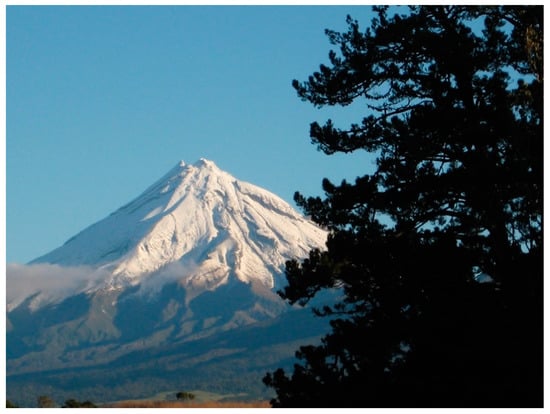
Figure 1.
Mount Taranaki on the North Island of New Zealand. (Photograph. by salng [CC-BY-SA 3.0 (http://creativecommons.org/licenses/by-sa/3.0]).
2. Hauraki: Northern Winds
The people that I trace my maternal ancestry through most likely arrived in Aotearoa/New Zealand from Eastern Polynesia in a series of migrations sometime between 700 and 2000 years ago. Over time, they split into iwi (tribes) and hapū (sub-tribes) that were collectively called Māori (King 2003) by British settlers. The name for our islands, Aotearoa, means “the land of the long white cloud” in Māori, and includes the North Island, the South Island and a smaller one known as Stewart Island. Maryrose Houston, who grew up on the North Island, explains her own understanding of her connection to the tangata whenua (first peoples) of Aotearoa:
I don’t really identify as being Māori. Because of my strong northern whakapapa, I identify more with being from the North. From my mother’s side, Ngāti Kuri is my dominant iwi (tribe), of which I am very proud of. I am not sure of the specific names of my father’s iwi, but I know they are from Waikara and Hokianga, Northland. I also have ties to Ngāti Rēhia through my mother’s tupuna so, again, another northern iwi. On paper, for things like elections and statistics, I will choose Māori and Pākehā (European descent) as my dad’s father was from Scotland.[M. Houston, personal communication, 21 November 2018]
Like harakeke (flax), with its deep root system interconnecting to surrounding harakeke bushes, Māori are linked by our shared roots and whakapapa. My tribe, Te Atiawa, settled on the coast of the North Island as well. These connections have become even more complex as iwi have incorporated family lines from other cultures.
When we trace our whakapapa, a Māori word that blends whaka (a liminal process of becoming) and papa (something broad or flat such as a rock or board), we are sharing how our foundation as a people has come to be (Hudson et al. 2007, p. 44). In short, whakapapa provided a framework for Māori to explain concepts and narratives fundamental to their culture, identity, language, spirituality and worldview (Hudson et al. 2007; Mahuika 2019). Whakapapa is what connects all Māori to one another and is the central marker of traditional mātauranga Māori (Māori knowledge) (Clarke 2006).
Many traditional Māori iwi traced their lineages back to Io, the Supreme Being, through 21 phases down to Ranginui (Sky Father) and Papatūānuku (Earth Mother) (Irwin 1984). In his existence within the realm of Te Korekore (the world beyond every day experiences), Io is perceived as Io-matamoe, Io-mata-ane, Io-kore-te-whiwhia (Io of the slumbering countenance and Io of the calm and tranquil countenance) (Marsden 1981). Nevertheless, not all iwi trace their whakapapa back to Io. As a deity, he has been problematised as a corruption of the Christian name Jehovah that was borrowed from European missionaries (Simpson 1997). However, while Io is contentious, there is evidence that he was a legitimate aspect within Māori spirituality before the arrival of Christianity (Arthur 2017; Marsden 1981; Irwin 1984). Arthur (2017), for instance, has argued that the esoteric lore of Io is part of theological concepts such as the beginning of creation and an irreducible link to a creator.
Before European colonization, the relationship Māori had with land was intimate, emotional and spiritual (McKinley 1998, p. 40). Children were told that Papatūānuku, the Earth Mother, must be respected and cared for in ways that would allow her ecosystems to regenerate while also sustaining the land for people (Sinclair 1998, p. 98). Within this cosmology, her sons and daughters with Ranginui were important spiritual guardians. Tane, for example, was the kaitiaki (guardian) of the forest, Tangaroa was the kaitiaki of the sea and Rongo was the kaitiaki of herbs and root crops (Marsden and Henare 1992, p. 18). These atua (gods or deities) were acknowledged in whakapapa by tracing cosmological creation stories to specific tribal histories (Te Rito 2007a). To pay homage to this cycle, when a woman gives birth, she will return the afterbirth to the land (Te Rito 2007b). The word for both afterbirth and land is whenua, which signifies a physical connection between land and people in whakapapa (Te Rito 2007b). In families today, the spiritual connections to land are still important. Hēmi Dale, a principal lecturer at the University of Auckland on Māori education, explains how other parts of genealogy are connected to whakapapa:
Ancestry, genealogy, lineage, heritage, descent, tātai (recitation of genealogies); kāwai (lineage, pedigree); whakatupuranga (generation) are all concepts associated with the term whakapapa. In my view, they all speak to the notion of a belief in our connectedness as people and the connectedness of all living things.[H. Dale, personal communication, 19 November 2018]
Hēmi Dale’s reflections are similar to the findings in Melinda Webber’s research (Webber 2007)—having a connection to one’s whakapapa is considered a requisite to any claim to “being Māori.” Whether a person’s knowledge of their whakapapa remains relatively intact or has been fragmented due to colonization, urbanization and/or intermarriage (Connor 2006), the overarching way of understanding genealogy creates a sense of responsibility to others that can be re-established by connecting to these lineages (Hoskins 2012).
Research in counseling with people of Māori descent has also found that for people of mixed Māori/Pākehā descent, it is important to explore Pākehā identity as well (Webber 2007). When European explorers, traders and settlers first made contact with Māori, cross-cultural relationships developed and families emerged out of the early trading communities. Our futures been the subject of debate ever since (Rocha and Wanhalla 2018, p. 15). For many people in Aotearoa/New Zealand, the term Pākehā encompasses people of European descent—particularly those who can whakapapa back five or more generations to England, Scotland, Wales and Ireland—whose ancestors emigrated to the islands in the South Pacific. From this perspective, Pākehā culture and identity are intrinsically linked to the construction of New Zealand as home place whose dominant culture continues to privilege Western cultural knowledges more than indigenous ones (King 1991). Given this power imbalance, Kīmai Tocker explains the importance of knowing her whakapapa on both sides of her family:
Knowing my whakapapa enables me to state proudly, “I am Māori” and to feel comfortable with the knowledge that I can be at home on a number of marae amongst my hapū and iwi through ties that descend from my mother. My identity is strengthened through the inclusion of my Pākehā and Jewish whakapapa—the heritage that comes from my father’s lineage.[K. Tocker, personal communication, 29 November 2018]
Kīmai recognizes multiple lineages, which brings up how distinct cultures can be maintained within an increasingly mixed-blood Māori population (Allen 2002). Concentrating on “blood” narratives, for instance, are inevitably controversial as they often raise disturbing questions about how these categories developed out of policies connected to scientific racism (Allen 2002). On one hand, Western conceptions of “being Māori” racialize indigenous identity, but on the other consider the identity a learned cultural construct. In her work on developing models for indigenous counseling, Love has concluded that:
Definitions of Māori based on the concept of “Māori culture” are genocidal because the culture concept is predicated on a conceptualization of “Māori culture” as learned, and as measurable in relation to, and in comparison with, Western constructions of “traditional (pre-European) Māori culture.”(Love 1999, pp. 54–57)
These Western conceptualizations of race, ethnicity and culture may also be used as membership categorisation devices within Māori community themselves as ways to narrate stories of the self. However, people can be alienated from their own experiences when they do not “fit” into the categories developed by both insiders and outsiders (Bell and Hawkes 1987; Hutching 1993; Marks 1989; Shostak 1981).
In this article, I will use auto-ethnography as a method to look at the complexity of cross-cultural genealogy. One of the most significant features of auto-ethnography is that it reveals “the absent self” in academic writing, which provides the opportunity to make connections that would normally be obscured (Doty 2010). Gatson (2003), for instance, describes writing about her personal self as an ethnographic exploration of cultural identities that can be overlooked or misunderstood as polar opposites. Boylorn (2014) suggests that auto-ethnography examines the everydayness of life to make sense of the self. For her, the method includes an interrogation not only how the place called home provided security and safety but also instigated prejudices. Art and photography can also be important bridges between different sides of one’s family (2003). In day to day life, these worlds may remain relatively separate, but including accompanying images bring a person’s full life together in a way that can be healing.
3. Te Ati Awa
I grew up in East Auckland in the small seaside settlement of Beachlands. Bound on two sides by the sea, it has several secluded bays with spectacular views of the islands in the Hauraki Gulf. See Figure 2. Beachlands is the next marine suburb to Maraetai and Howick was our nearest town, 19.5 km away. See Figure 2.
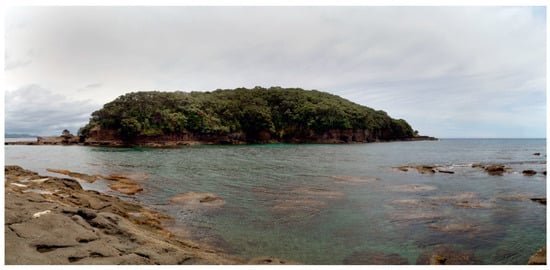
Figure 2.
One of the islands in the Gulf of Hauraki (Northern Winds) near Beachlands.
Beachlands was my home place, not just because of our physical home and family life, but because on my Pākehā side four generations of my father’s family had made their home in East Auckland, which places me in a direct line to the colonization of Aeotora/New Zealand. As Turner (2002) argues, the colonial wanted to subordinate their new home place to replace the one they came from, to make it home like the old country. But as this autoethnography will show, it did not always turn out that way. On my Māori side, my family history places me historically as tangata whenua (people of the land). Negotiating two stories within the essence of self creates a history of place and home that is often contradictory. East Auckland was my home, but 345.7 km away on the west coast of the North Island of Aotearoa/New Zealand, Taranaki was my tūrangawaewae (home place through whakapapa).
My iwi, Te Āti Awa, is from the Taranaki rohe (district). According to legend, the people of Te Āti Awa are descended from Awanuiarangi, the son of a woman, Rongoueroa, and a spirit descended from the sky, Tamarau-te-heketanga-a-rangi (Adds 2005). While this whakapapa is not linked to Io, there is a strong link with the spiritual world. The tribal migration stories to Aotearoa/New Zealand were also very important to each iwi and whakapapa. In pre-European times, they were memorized and transmitted orally from generation to generation (Te Rito 2007a). One of the earliest Taranaki waka (canoe) traditions names the rangatira (chief) Manaia as the captain of the Tokomaru canoe (Taonui 2005). See Figure 3.
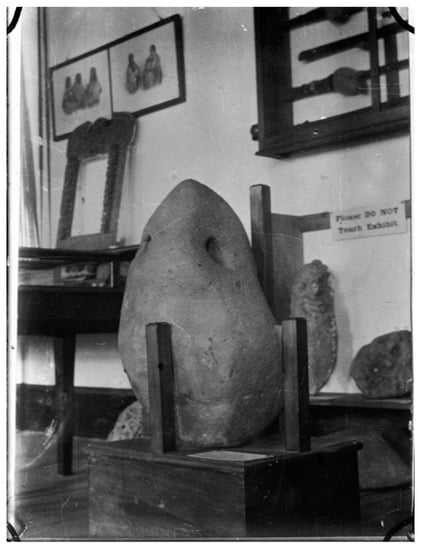
Figure 3.
The punga waka (stone anchor) of the waka (canoe) Tokomanu navigated by Manaia on display in 1934 at the Taranaki Museum in New Plymouth. It was one of the original ocean-navigating canoes that settled Aotearoa/New Zealand. Photograph by Albert Percy (1875–1941), courtesy of the Goldberg Collection, Alexander Turnbull Library Collections at the National Library of New Zealand.
Our whanau has been able to trace our whakapapa back some ten plus generations to Whiti-o-Rongomai, founder of Ngati Te Whiti (Taranaki iwi). Our great-great-great-great-grandfather was Ngatata-i-te-Rangi (also known as Makoare Ngatata). See Figure 4. Born around 1790, Ngatata-i-te-Rangi was the son of Te Rangiwhetiki and Pakanga. Through Pakanga, he was an influential rangatira in the Ngati Te Whiti hapū of Te Atiawa. On 29 April 1840, Ngatata i te rangi (1794–1854) signed the Henry Williams version of Te Tiriti o Waitangi (Treaty of Waitangi, the founding document of Aotearoa/New Zealand) on the schooner, the Ariel, at Port Nicholson (Wellington), which was witnessed by Henry Williams and George Thomas Clayton (Orange 1990). With this treaty, the British admitted they did not succeed in conquest. Instead, the treaty guaranteed tino rangatiratanga to Māori (self-determination for Māori) and developed a kaupapa (philosophy) of partnership between Māori and Pākehā. Unfortunately, the colonization period eroded te reo Māori (Māori language) and tikanga Māori (Māori culture) and this “partnership” was not put into practice. With the advent of the Māori Renaissance, a social movement of the late 1970s and early 1980s, there has been more demands for the full actualization of the Treaty of Waitangi (Keegan 2017). See Figure 4.
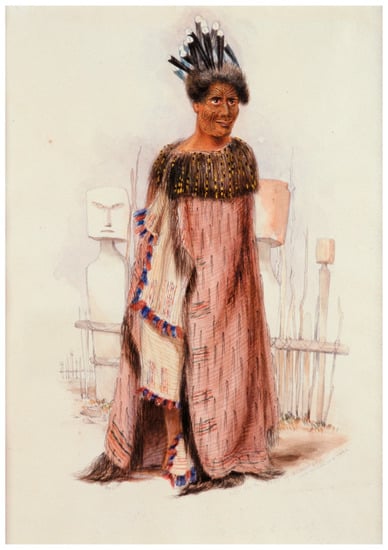
Figure 4.
Ngatata-i-te-Rangi (also known as Makoare Ngatata) by George French Angas (1844). Watercolour and gum Arabic 324 × 227 mm. Image courtesy of The Fletcher Trust Collection, New Zealand.
In the 2010 exhibit Pākehā Colonisation and Māori Empowerment at the Waikato Museum, a water color of Ngatata-i-te-Rangi by the English artist George French Angas (1822–1886) was included to highlight how settler colonialists’ depictions of Māori created a complicated archival record (Shaw n.d.). Angas’s accurate attention to Ngatata-i-te-Rangi’s style and clothing provide important visual depictions of royal aesthetics. His hair is pulled back into a top knot with feathers crowning his head with the coveted black feathers with white tips of the huia bird (Buck 1949). Another sign of Ngatata status as rangatira is his kākahu (cloak), which was traditionally woven by esteemed kuia (older women). It was considered a privilege to wear such a garment (Malcolm-Buchanan et al. 2012) and contemporary Māori weavers have studied the painting to help them learn about different patterns (Diamond 2010). Despite this attention to detail of material culture, Angas’s depiction of Ngatata’s expression fits into Eurocentric caricatures of Indigenous peoples, which unfortunately has had a strong impact around the world. As Jo Diamond writes:
Angas was able to distribute his work internationally, relying on this evocation of “savagery”. It is more valid to consider Nga Tata as he was: one of a long line of rangatira, whose standing, like that of many from a ruling class including those of Europe, relied more heavily on mana, political acumen and charisma than on savage atrocity.(Diamond 2010)
Ironically, the moko (tattoo design) in the painting, which may have caused culture shock in European viewers, contains information that is a counter narrative to the European stereotypes explaining his lineage, rank and iwi (tribe) to those who can read it. The moko also reveals his mana (status) and is imbued with its own energy (Palmer and Tano 2004).
The importance of the moko reveals how traditional Māori culture valued narratives of selfhood that privileged the collective over the individual. Views of the self are developed in community—an individual’s inherited status, different relationships with the whanau and hapū, as well as with the atua, will be the first ways others will understand them (Smith 1981). Autonomy of the self was usually limited to these conditions outside of the individual’s control. A man or woman could only be someone inside her/his kin group—outside of it, they were no one (Smith 1981).
We can see the way that concepts of whakapapa are represented through a portrait of my great-great-great-grandmother, Ngapei Ngatata (born circa 1811). See Figure 5.
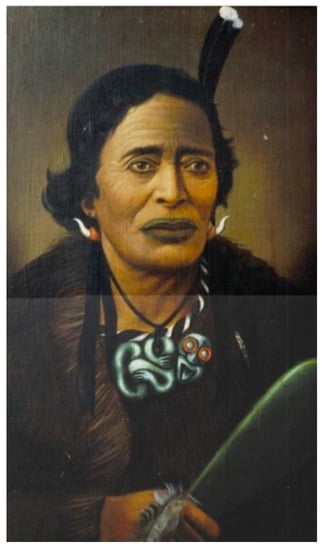
Figure 5.
Ngapei Ngatata. Oil painting (26″ × 20″). Artist unknown. Image courtesy of Puke Ariki in New Plymouth, New Zealand.
The fifth child of Ngatata-i-te-Rangi, Ngapei’s status as the daughter of a rangatira (chief) is marked with the moko around her lips, the large pounamu (green stone) patu (club) she is holding and the large pounamu hei tiki (necklace representing humankind) around her neck. She is also wearing shark tooth earrings and has a feather in her hair, representing her iwi (tribe), Te Atiawa. The korowai (cloak) draped across her shoulders further symbolises her status.
Ngapei’s family offered her as a common-law wife to Captain John George Cooke in hopes of cementing good relations with Pākehā settlers. See Figure 6. The marriage symbolised the concept of Tatau Pounamu (peace-making) (Marsh 2012). John George Cooke was the son of Christopher and Elizabeth Austen Cooke, who was related to the English novelist, Jane Austen. The Te Atiawa tribe hoped the relationship would connect two worlds together (Marsh 2012). Ngapei had two children with Cooke: Te Piki Ngatata, also known as Mary Ann Cooke, and George Gray Cooke (who died when he was 19). Cooke returned to England in 1850. Ngapei continued to live on her ancestral land, the Te Puia reserve at Waiwhakaiho, Taranaki. Later in her life, she also lived with Te Piki (Mary Anne) and her husband, George Augustus Skeleton, on Smart Road, New Plymouth (Duckett 2013). See Figure 6.
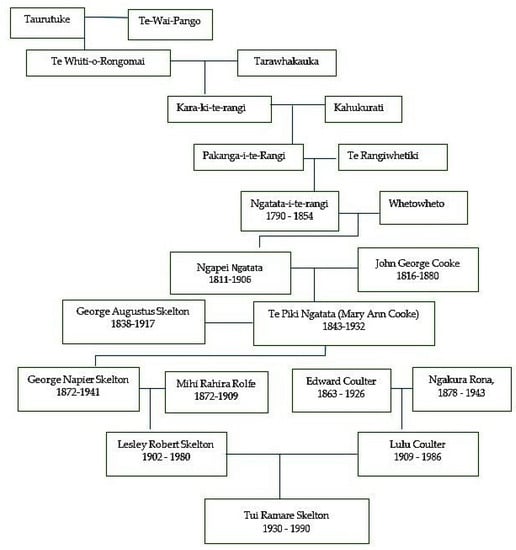
Figure 6.
Whakapapa of Helene Connor’s mother’s paternal line.
Te Piki/Mary Ann’s use of two names is a small example of how my family moved between different cultural identities. Their grandson, Lesley Robert Skelton, married Lulu Coulter, a young woman who had grown up in a mixed family in the province of Taranaki. Her mother, Ngakuru Rona, was Māori and her father, Edward Coulter, was Pākehā. As a child, she was taught te reo Māori (Māori language) and was connected to her family’s marae, Ōwae Waitara Marae, which linked those who whakapapa to Te Āti Awa iwi (tribe). Overlooking the Waitara River, the Te Ika-roa-a-Māui (large meeting house at the marae) is constructed in the traditional manner with carvings and flax weavings adorning its walls. See Figure 7.
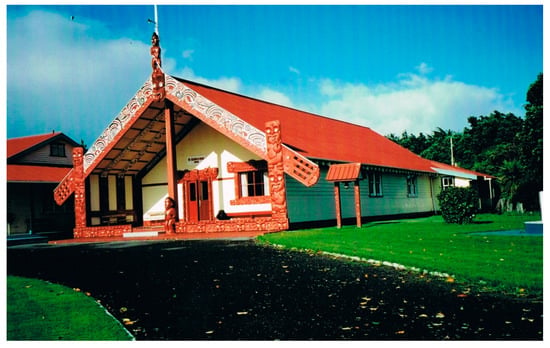
Figure 7.
The carved wharenui (large house), Te Ika-roa-a-Māui, Ōwae Waitara Marae, Waitara, Taranaki. Private collection of Helene Connor.
The architecture and art of the marae creates a papakāinga (home base) that connects tupuna (ancestors) with turangawaewae (a place to stand) (Connor 2003).
4. Manaakitanga (Hospitality)
Lesley and Lulu Skelton raised their children on a dairy farm in Motunui, a settlement in northern Taranaki where they had around 50 cows. My mother, Tui, is their oldest child. Like her mother and mother-in-law, Lulu held onto the Māori traditions embedded in manaakitanga (hospitality). Anyone who visited the old farmhouse would get a warm welcome. She was the life and soul of the whanau (family). Lulu sewed clothes for her entire family on an old treadle sewing machine, played the piano by ear and had a beautiful singing voice. She grew a huge vegetable garden, which fed her large family and many others. She also kept chickens for eggs and poultry and prepared traditional Māori kai (food) using food preparation practices she learned from the women in her family. Lulu’s mother and beloved aunt Tangiora, her mother’s sister, taught her how to cook fresh kaimoana (seafood), which was collected from the local beach, including kōtoretore (red sea anemone), which were found in rock pools that were slow cooked for several days. Another time-intensive dish was karaka berries, which can be poisonous unless cooked correctly. The preparation involves days of soaking and endless boiling and straining.
My mother remembers the heart of the family being centred around the old coal range in the kitchen where all this preparation was done. Everything happened around the hearth. Endless meals and cups of tea were prepared there and it provided warmth and comfort for the whole family. All the children became adept at lighting it and judging the various temperatures required for baking and cooking. They could toast bread in the fire box, bake pikelets on the stove top and scones in the oven—delicious with Lulu’s homemade strawberry jam and fresh whipped cream. Christmas time was usually shared with extended whanau and neighbours. She prepared a gigantic Christmas family picnic. The children loaded the truck up and they trekked off to some outlying place—the bush or the lake—and dragged all the gear up there to enjoy lunch. When the parents fell asleep, the children ran riot in the bush to explore new territory.
Growing up in Beachlands away from the family farm, I looked forward to getting my grandmother’s letters and began writing letters back to her as soon as my mother taught me to read when I was four years old. See Figure 8.
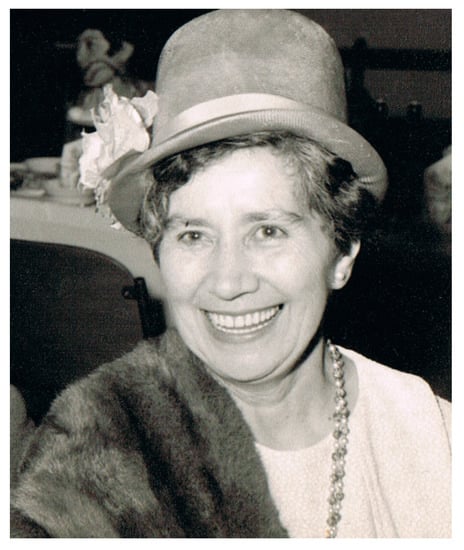
Figure 8.
Lulu Coulter Skelton in her 50s. Photograph courtesy of Helene Connor.
When my family visited my grandparents, Lulu often took me to the Ōwae Waitara Marae with her. She was staunchly proud of it and loved spending time there meeting up with her contemporaries. They would kōrero (talk) in te reo Māori and there was always a lot of laughter. They would all share kai (food) in the whare kai (dining house) after their hui (meeting). In the 1980s, Lulu became a kaiako (teacher) at the Waitara kohanga reo (language nest where she taught pre-school children in te reo Māori. In her later years, she also worked to preserve traditional knowledge about different harakeke (flax) varieties. She taught young people about the care of harakeke and went on planting expeditions all over Taranaki.
After Lulu died in 1986, I found out she had kept all of the letters and cards I sent throughout the years—literally hundreds of correspondences, from my first fledging hand-written notes to long letters crafted on a computer. I, too, have kept many of her letters, carefully, wrapped in one of her old scarves, one of my most precious taonga (treasures). Since her death, the marae has helped us stay connected to our family. One very special occasion involved the recognition of my whanaunga (relation), Mina Timutimu, who had whakapapa ties to Te Āti Awa iwi and Ngati Rahiri hapu. For her 50-year career as a nurse and midwife, Mina was awarded a Member of the New Zealand Order of Merit (MNZM) in 2016 and our hapu celebrated her award at Ōwae. Hundreds of whanau (family), friends and colleagues who were both Māori and Pākehā attended the event and whaikorero (formal speeches) were spoken in her honour, followed by waiata (songs). After the speeches and acknowledgements of her work, a magnificent feast was served in the whare kai. The celebration to honour her achievements can be viewed as whakapapa in action within the cultural context of marae protocol.
5. Two-Rivers
On my paternal side, I am descended from Irish immigrants. The Irish were also colonized by the English and the remnants of this bitter colonial past remain as one of the intricate historical complexities for Irish identity, just as it does for Māori. The meaning of Irishness and how the Irish negotiate a path between conflicting cultures and the Catholic and Protestant traditions, the two languages of Gaelic Irish and Anglo Irish, are complicated enough for the Irish in Ireland. For those of us who are Irish in our heritage but for whom Ireland remains terra incognita (unknown territory), a sense of being Irish is further compounded by our fragmented knowledge of the traditions, landscape and culture of our Irish ancestry.
My own sense of Irish heritage comes from the bond I had with my Irish grandmother, Helen Elizabeth (McGinty) Kelly. I was named after her, our birthdays were two days apart and we shared a deep emotional and psychological connection. See Figure 9.
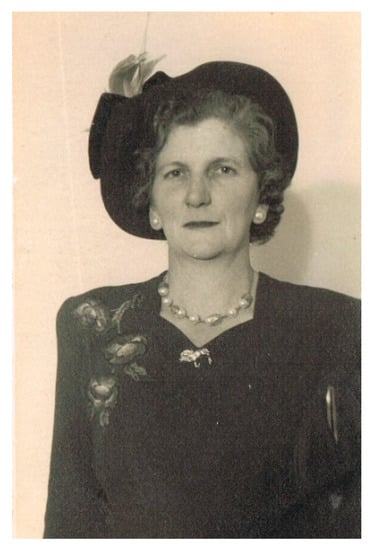
Figure 9.
Helen Elizabeth (McGinty) Kelly, aged in her 50s, n.d. Photograph courtesy of Helene Connor.
Helen’s grandmother, Alice, came to New Zealand on one of the migrant ships, the Doric. The Doric left London for New Zealand on July 1883 on its maiden voyage via Capetown. It had accommodation for seventy first class passengers and 900 emigrant class passengers (The Ships Lists 2010). Her grandmother said the journey was very grim. Many children became very ill with measles and were taken to the quarantine station at Motuihi Island when they docked.
Helen grew up in East Auckland in the small seaside village of Maraetai. In the late 1840s, Europeans began to settle the Maraetai area and many formed alliances with the local iwi (tribe) Ngā Tai (La Roche 2017). When Helen was a girl, the Ngā Tai people still lived at a Māori village known as Maraetai Pā. She told me stories of how she spent many hours playing with Ngā Tai children at Maraetai Beach and had a special friendship with a kuia whom she called Whaea (mother) Makere (Maggie). Whaea Makere taught her how to prepare many of the native vegetables including pūhā, a type of sow thistle, and kowhitiwhiti, or watercress. Whaea Makere also included Helen in excursions to the beach when she taught her mokopuna (grandchildren) how to gather and cook kaimoana.
The nearest town to Maraetai was Howick. It was here Helen attended mass at Our Lady Star of the Sea Catholic Church. The first church was a wooden structure, built in 1854 by former Marist missionary, Father Antoine Garin, who had been appointed by Bishop Pompallier, New Zealand’s first Catholic Bishop (La Roche 2017). Helen and all of her children attended Our Lady Star of the Sea’s school. See Figure 10.
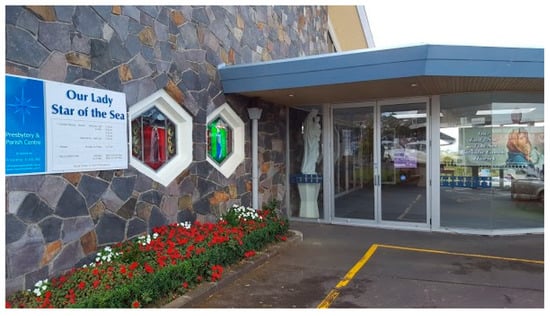
Figure 10.
Our Lady Star of the Sea Catholic Church, Picton Street, Howick, East Auckland. Photograph courtesy of Helene Connor.
When Helen married Stanley Kelly, they moved to a small farm at Whitford on the outskirts of Howick. She had nine children, including two sets of twins. My father, Norman, was her oldest son. They all attended Our Lady Star of the Sea’s school. My blond and blue-eyed father was the only person in his family who married a Māori. Stanley was opposed to my parents’ marriage and I always felt uncomfortable around him as he rarely spoke to me and seemed very distant and cold. Amongst our other cousins, my brother Grant and I stuck out as being very different in colouring and looks to the rest of our Pākehā cousins who are quite fair.
Experiencing a mixed cultural heritage is steeped in contradiction and ambiguity. Historically, interracial marriages/relationships and the children of these unions have been viewed with hostility by both sides. The theme of “mixed-blood” is a relatively enduring theme in Aotearoa/New Zealand. Māori writer Harry Dansey (Dansey 1978) distinguishes between what he terms the “brown Pākehā,” someone who may look Māori but accentuates the European side of her/his identity, and the “white Māori,” someone who is European in appearance but who accentuates the Māori side of their identity. Known as “passing”—when a person of one race, gender, nationality or sexual orientation adopts the guise of another—this term often assumes an unequal binary (Ginsberg 1996). Yet moving between two worlds is not always simply about erasure or denial, but rather about the creation and establishment of alternative experiences.
My grandmother was always accepting of her two grandchildren of mixed heritage. As a girl, we were very close and I loved visiting her at the homestead where she listened to Irish music and she often partook in the Irish tradition of gambling, especially, horse racing. She also enjoyed a good drop of Irish whiskey, particularly on St Patrick’s Feast Day, and cooked Irish soda bread. Her relationships with her daughter-in-law Tui and grandchildren returned her, in some ways, to a culture that she had once felt some belonging. I share it here in the hope that we can create new stories that do not have to clash with communal presentations of family (Schlossberg 2001).
In an exploration of writings about mixed identity in Aotearoa /New Zealand, Alice Te Punga Somerville (Somerville 1998) writes about the mixed ethnicity of Māori and Pākehā in a poetic and affirming way by declaring, “two rivers within me flow.” I tautoko (support) her metaphor as encapsulating the reality of mixed parentage, while also recognizing that the social and political realities of racism in the country mean if “you have one spot of Māori blood, you are Māori.” For many Māori, but by no means all, it does not mean you have to deny your Pākehā side, but it does imply taking an important political position, as identifying as Māori is a strategy of survival.
Growing up, there were many times in my own family where this decision has to be made. I can vividly recall one of my Pākehā cousins asking me if my mother, Tui, washed the lettuce before she made a salad. The implication was that as a Māori she lacked knowledge of food preparation and hygiene. I also remember one of my aunts telling my mother not to bring the food she had made for a family lunch into her house. My father was livid and refused to speak to his sister for many years after this blatant insult. Tui was also subjected to prejudice in her job. A qualified and registered primary school teacher who taught at the local school, some Pākehā parents refused to have a Māori teach their children and removed their children to other schools in the area. Ironically, many of these parents later returned to the local school when they found out what an exemplary teacher she was.
How we negotiate mixed identity is a matter of individual choice, but having connections to one’s whakapapa helps create a strong foundation (Cheater and Hopa 1997). When my daughter was a baby I honoured both my Pākehā and Māori sides. She was given an English name and a Māori middle name, Tangiora, to acknowledge my Māori nannie’s dearly loved aunt. I also paid homage to both my grandmothers by ensuring my daughter was immersed in rituals belonging to both sides of her whakapapa/genealogy. Soon after Carabelle’s birth she was baptized at Our Lady Star of the Sea Catholic Church in Howick, the church Mama Nellie attended throughout her life. Six months after Carabelle’s birth we made the long journey to Taranaki to introduce her to her extended Māori whanau and to bury her whenua (placenta). Her whenua was buried on traditional Ngati Rahiri hapu (subtribe) land, at the foot of a Pohutukawa tree overlooking the sea, her papākainga and the place where her whakapapa connects her. See Figure 11.
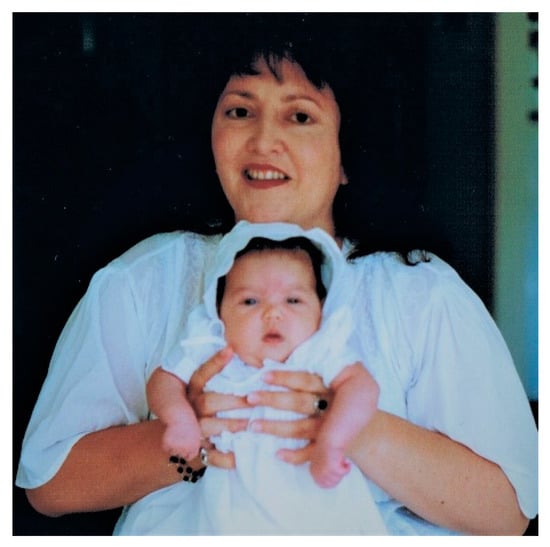
Figure 11.
Helene Connor and her daughter, Carabelle Tangiora Connor, on the occasion of her baptism, 1 March 1998, Our Lady Star of the Sea Catholic Church, Howick, East Auckland. Photograph courtesy of Helene Connor.
Funding
This research received no external funding.
Conflicts of Interest
The author declares no conflict of interest.
References
- Adds, Peter. 2005. ‘Te Āti Awa of Taranaki’, Te Ara—The Encyclopedia of New Zealand. Available online: https://teara.govt.nz/en/te-ati-awa-of-taranaki (accessed on 4 December 2019).
- Allen, Chadwick. 2002. Blood Narrative: Indigenous Identity in American Indian and Māori. Durham: Duke University Press. [Google Scholar]
- Arthur, Jonathan. 2017. Io-urutapu: The Māori Supreme Being. Stimulus: The New Zealand Journal of Christian Thought and Practice 24: 29. Available online: https://hail.to/laidlaw-college/publication/cGDYGRc/article/OryhP4N (accessed on 4 December 2019).
- Bell, Diane, and Ponch Hawkes. 1987. Generations: Grandmothers, Mothers and Daughters. Fitzroy: McPhee Gribble/Penguin. [Google Scholar]
- Boylorn, Robin M. 2014. From Here to There: How to Use Auto/ethnography to Bridge Difference. International Review of Qualitative Research 7: 312–26. [Google Scholar] [CrossRef]
- Buck, Peter. 1949. The Coming of the Māori. Available online: http://nzetc.victoria.ac.nz/tm/scholarly/tei-BucTheC-t1-g1-t2-body1-d13-d3.html (accessed on 4 December 2019).
- Cheater, Angela, and Ngapare Hopa. 1997. Representing identity. In After Writing Culture; Epistemology and Praxis in Contemporary Anthropology. Edited by Allison James, Jenny Hockey and Andrew Dawson. London: Routledge, pp. 208–23. [Google Scholar]
- Clarke, Eileen. 2006. From Kaitiaki to branch office: The bureaucratisation of whakapapa. AlterNative: An International Journal of Indigenous Peoples 2: 138–73. Available online: https://journals.sagepub.com/doi/10.1177/117718010600200107 (accessed on 4 December 2019).
- Connor, D. Helene. 2003. Land, notions of ‘home’, and cultural space. In Gender and Power in the Pacific: Women’s Strategies in a World of Change: Women’s Strategies in a World of Change. Edited by Katarina Ferro and Margit Wolfsberger. London: Transaction Publishers, pp. 159–84. [Google Scholar]
- Connor, D. Helene. 2006. Writing Ourselves ‘Home’: Biographical Texts: A Method for Contextualizing the Lives of Wahine Māori. Locating the Story of Betty Wark. Ph.D. dissertation, University of Auckland, Auckland, New Zealand. [Google Scholar]
- Dansey, Harry. 1978. Māori Custom Today. Auckland: Shortland Publications. [Google Scholar]
- Diamond, Jo. 2010. Nga Tata, Chief of Kumutoto and Father of E Tako. Available online: http://fletchercollection.org.nz/artworks/nga-tata-chief-of-kumutoto-and-father-of-e-tako/ (accessed on 4 December 2019).
- Doty, Roxanne Lynn. 2010. Autoethnography—Making Human Connections. Review of International Studies 36: 1047–50. [Google Scholar] [CrossRef]
- Duckett, Graeme. 2013. A Matter of Life and Death. Available online: https://www.pressreader.com/new-zealand/taranaki-daily-news/20130730/281779921746542 (accessed on 4 December 2019).
- Gatson, Sarah N. 2003. On Being Amorphous: Autoethnography, Genealogy, and a Multiracial Identity. Qualitative Inquiry 9: 20–48. Available online: https://doi-org.ezproxy.auckland.ac.nz/10.1177/1077800402239338 (accessed on 4 December 2019).
- Ginsberg, Elaine K., ed. 1996. The politics of passing. In Passing and the Fictions of Identity. London: Duke University Press, pp. 1–18. [Google Scholar]
- Himona, Ross. 2001. Whakapapa. Available online: http://maaori.com/whakapapa/whakpap2.htm (accessed on 4 December 2019).
- Hoskins, Te Kawehau. 2012. A fine risk: Ethics in Kaupapa Māori politics. New Zealand Journal of Education Studies: Te Hautaka Mātai Mātauranga 47: 85–99. [Google Scholar]
- Hudson, Maui L., Annabel Ahuriri-Driscoll, Marino G. Lea, and Rod A. Lea. 2007. Whakapapa—A Foundation for Genetic Research? Bioethical Inquiry 4: 43–49. [Google Scholar] [CrossRef]
- Hutching, Megan. 1993. Talking History: A Short Guide to Oral History. Wellington: Bridget Williams Books/Historical Branch, Department of Internal Affairs. [Google Scholar]
- Irwin, James. 1984. An Introduction to Māori Religion. Bedford Park: Australian Association for the Study of Religions. [Google Scholar]
- Keegan, Peter. 2017. On changes in New Zealand Māori Narrative: How an indigenous culture enables the modern world. In Following Forkhead Paths: Discussions on the Narrative. Edited by Debashree Dattaray, Epsita Haldar and Sudip Bhattacharya. Kolkata: Archana Das & Subrata Das, pp. 27–41. [Google Scholar]
- King, Michael. 1991. Pākehā: The Quest for Identity in New Zealand. Auckland: Penguin. [Google Scholar]
- King, Michael. 2003. The Penguin History of New Zealand. Auckland: Penguin Group. [Google Scholar]
- La Roche, Alan. 2017. Howick’s First Churches. Available online: https://www.times.co.nz/howick-170-years/howicks-first-churches/ (accessed on 4 December 2019).
- Love, Catherine. 1999. Māori Voices in the Construction of Indigenous Models of Counselling Theory and Practice. Ph.D. dissertation, Massey University, Palmerston North, New Zealand. [Google Scholar]
- Mahuika, Nēpia. 2019. A brief history of whakapapa: Māori approaches to genealogy. Genealogy 3: 32. [Google Scholar] [CrossRef]
- Malcolm-Buchanan, Vincent, Ngahuia Te Awekotuku, and Linda Waimarie Nikora. 2012. Cloaked in Life and Death. Korowai, kaitiaki and tangihanga. Mai Journal 1: 50–60. Available online: http://www.journal.mai.ac.nz/sites/default/files/MAI_Journal_V1%2C1_MalcolmBuchanan_etal.pdf (accessed on 4 December 2019).
- Marks, Shula. 1989. The context of personal narrative: Reflections on “not either an experimental doll”: The separate worlds of three South African women. In Interpreting Women’s Lives: Feminist Theory and Personal Narratives. Bloomington: Indiana University Press, pp. 39–58. [Google Scholar]
- Marsden, Māori, and T. A. Henare. 1992. Kaitiakitanga: A Definitive Introduction to the Holistic World View of the Māori. Wellington: Ministry for the Environment. [Google Scholar]
- Marsden, Māori. 1981. God, man and the universe: A Māori view. In Te ao Hurihuri: Aspects of Māoritanga. Edited by Michael King. Auckland: Longman Paul, pp. 143–64. [Google Scholar]
- Marsh, Melissa. 2012. Golf Links Residential Subdivision Pre-Colonial History Report: The story of Ngapei Ngatata and John George Cooke. New Plymouth: Taranaki. [Google Scholar]
- McKinley, Elizabeth. 1998. Māori women and natural resource management: Towards a sustainable future. In Indigenous Women: The Right to a Voice. Edited by Diana Vinding. Copenhagen: IVVGIA, pp. 36–49. [Google Scholar]
- Mead, Hirini, and Neil Grove. 2001. Ngā Pēpeha a ngā Tīpuna. Wellington: Victoria University Press. [Google Scholar]
- Orange, Claudia. 1990. An Illustrated History of the Treaty of Waitangi. Wellington: Allen and Unwin. [Google Scholar]
- Palmer, Christian, and Mervyn L. Tano. 2004. Mokomokai: Commercialization and Desacralization. Available online: http://nzetc.victoria.ac.nz/tm/scholarly/tei-PalMoko-t1-body-d1-d2.html (accessed on 4 December 2019).
- Rocha, Zarine L., and Angela Wanhalla. 2018. A history of mixed race in Aotearoa/New Zealand. In Mana Tangatarua: Mixed Heritages, Ethnic Identity and Biculturalism in Aotearoa/New Zealand. Edited by Zarine L. Rocha and Melinda Webber. New York: Routledge, pp. 15–31. [Google Scholar]
- Schlossberg, Linda. 2001. Rites of passing. In Passing: Identity and Interpretation in Sexuality, Race, and Religion. Edited by Maria C. Sánchez and Linda Schlossberg. New York: New York University, pp. 1–12. [Google Scholar]
- Shaw, Peter. n.d. Nga Tata, Chief of Kumutoto and Father of E Tako. Available online: http://fletchercollection.org.nz/artworks/nga-tata-chief-of-kumutoto-and-father-of-e-tako/ (accessed on 4 December 2019).
- Shostak, Marjorie. 1981. Nisa: The Life and Words of a Kung Woman. New York: Vintage Books. [Google Scholar]
- Simpson, Jane. 1997. Io as Supreme Being: Intellectual colonization of the Māori? History of Religions 37: 50–85. [Google Scholar] [CrossRef]
- Sinclair, Moana. 1998. Pākehā land legislation in Aotearoa: The continuous resistance by Māori women. In Indigenous Women: The Right to a Voice. Edited by Diana Vinding. Copenhagen: IVVGIA, pp. 92–102. [Google Scholar]
- Smith, Jean. 1981. Self and experience in Māori culture. In Indigenous Psychologies and the Anthropology of the Self. Edited by Paul Heelas and Andrew Lock. London: Academic Press, pp. 145–59. [Google Scholar]
- Somerville, Alice Te Punga. 1998. Two Rivers within Me Flow: An Exploration of Mixed Race Writing in Aotearoa/New Zealand. Master’s dissertation, University of Auckland, Auckland, New Zealand. [Google Scholar]
- Taonui, Rāwiri. 2005. Canoe Traditions—Canoes of the West Coast and Lower North Island. Te Ara—The Encyclopaedia of New Zealand. Available online: https://teara.govt.nz/en/canoe-traditions/page-7 (accessed on 4 December 2019).
- Te Rito, Joseph. 2007a. Whakapapa: A framework for understanding identity. MAI Review 2: 1–10. Available online: http://www.review.mai.ac.nz/MR/article/view/56/55.html (accessed on 4 December 2019).
- Te Rito, Joseph. 2007b. Whakapapa and whenua: An insider’s view. MAI Review 3: 1–8. Available online: https://researchspace.auckland.ac.nz/handle/2292/16518 (accessed on 4 December 2019).
- The Ships Lists. 2010. Doric 1883. Available online: http://www.theshipslist.com/ships/descriptions/ShipsD.shtml (accessed on 4 December 2019).
- Turner, Stephen. 2002. Being Colonial/Colonial Being. Journal of New Zealand Literature: JNZL 20: 39–66. Available online: http://www.jstor.org.ezproxy.auckland.ac.nz/stable/20112341 (accessed on 4 December 2019).
- Webber, Melinda. 2007. Hybrid Māori/Pākehā: Explorations of Identity of Mixed Māori/Pākehā Descent. Master’s dissertation, University of Auckland, Auckland, New Zealand. [Google Scholar]
© 2019 by the author. Licensee MDPI, Basel, Switzerland. This article is an open access article distributed under the terms and conditions of the Creative Commons Attribution (CC BY) license (http://creativecommons.org/licenses/by/4.0/).